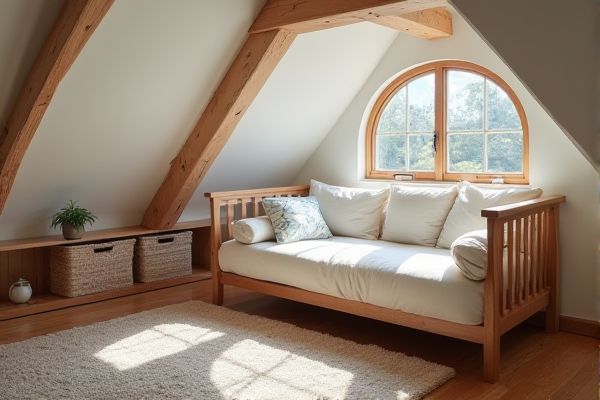
Daybeds offer a stylish seating option that transitions easily into a bed, making them ideal for attic spaces where maximizing functionality and comfort is key. Discover how choosing between a daybed and a futon can transform your attic into a versatile living area by reading the rest of the article.
Table of Comparison
| Feature | Daybed | Futon (Attic) |
|---|---|---|
| Design | Bed frame with back and sides, often stylish for lounging | Convertible sofa-bed, designed for small spaces like attics |
| Functionality | Used as seating by day and bed by night | Transforms easily from couch to bed |
| Space Efficiency | Requires more dedicated corner or wall space | Optimized for tight or multifunctional attic rooms |
| Comfort | Typically uses a mattress, offering good sleeping comfort | May have thinner mattress, balancing seating and sleeping comfort |
| Style | Classic, versatile with traditional and modern options | Casual, modern, often minimalist for attic use |
| Price Range | Moderate to high depending on materials | Generally affordable and practical |
Introduction: Daybed vs Futon for Attic Spaces
Daybeds offer a stylish and space-efficient seating option with a permanent backrest and can double as a sofa and bed, ideal for compact attic environments. Futons provide versatility by easily converting from a sofa to a bed, making them practical for small attic rooms where multi-functionality is essential. Both options maximize attic space, but daybeds typically emphasize design and comfort, while futons prioritize adaptability and quick transformation.
Space Efficiency: Which Saves More Room?
Daybeds offer greater space efficiency compared to futons in an attic setting due to their streamlined design that maximizes seating and sleeping options without bulky frames. Their compact structure fits easily against walls or corners, freeing up valuable floor space for other uses. Futons, while versatile, often require more clearance for folding and unfolding, making daybeds the superior choice for tight attic spaces.
Comfort Levels and Mattress Options
Daybeds typically offer higher comfort levels with thicker, more supportive mattresses such as innerspring or memory foam, ideal for extended sitting and sleeping. Futons often feature thinner, dual-purpose mattresses made from foam or cotton batting, which may compromise cushioning during prolonged use. Attic spaces benefit from daybeds when prioritizing comfort, while futons suit compact areas needing versatile furniture options.
Versatility in Function and Use
Daybeds provide versatile seating and sleeping options, often featuring storage compartments or trundle beds for added functionality in attic spaces. Futons easily transform from a sofa to a bed, maximizing limited attic areas by serving dual purposes without occupying extra room. Both options optimize attic usability through multifunctional design, but daybeds typically offer more structured support and aesthetic appeal.
Style and Aesthetic Appeal in Attics
Daybeds offer a sleek, elegant design that enhances the cozy ambiance of an attic with their structured frame and often decorative elements, making them ideal for creating a sophisticated nook. Futons present a more casual and versatile aesthetic, blending well in multifunctional attic spaces due to their minimalist style and easy convertibility. Your choice between a daybed and futon will impact the attic's visual flow, balancing either refined charm or laid-back versatility.
Ease of Assembly and Mobility
Daybeds typically offer easier assembly with fewer components and simpler instructions, making them ideal for quick setup in your attic space. Futons often require more effort to assemble due to their folding mechanisms and additional hardware but provide greater mobility by easily converting from sofa to bed and often include casters for smooth movement. Your choice depends on whether you prioritize straightforward assembly or versatile mobility in a tight attic environment.
Storage Solutions: Hidden Benefits
A daybed in your attic provides ample storage solutions with built-in drawers or under-bed compartments, maximizing space efficiency while keeping the area organized. Futons often lack substantial hidden storage, making daybeds a superior choice for maintaining clutter-free living spaces. Choosing a daybed enhances your attic's functionality by combining seating, sleeping, and storage benefits in one stylish piece.
Durability and Maintenance Comparison
Daybeds typically offer greater durability due to their sturdy wooden or metal frames designed to support regular use, making them ideal for attic spaces with variable conditions. Futons, with their foldable mattress and frame, may require more frequent maintenance to prevent sagging and wear, especially when stored in attics prone to humidity or temperature fluctuations. Choosing a daybed ensures easier upkeep and longer-lasting comfort in attic environments, while futons need more careful maintenance to maintain their functionality.
Price Points and Budget Considerations
Daybeds typically range from $200 to $700 depending on materials and design, offering a stylish yet functional option for attic spaces. Futons are generally more affordable, with prices starting around $150 and seldom exceeding $500, making them ideal for budget-conscious buyers. Choosing between a daybed and futon in an attic hinges on balancing cost with desired comfort and versatility.
Conclusion: Best Choice for Your Attic
A daybed offers a stylish and comfortable seating option with a minimalist design that maximizes space in an attic, making it ideal for both lounging and sleeping. A futon provides versatile functionality by easily converting from a sofa to a bed, perfect for small attic rooms requiring flexible furniture. Choosing between a daybed and futon depends on whether you prioritize aesthetic appeal with occasional use or frequent transformation for guests in your attic space.
 homyna.com
homyna.com